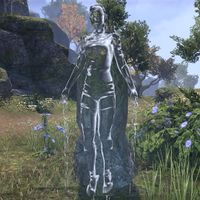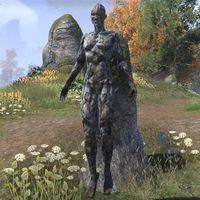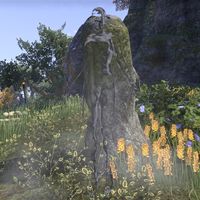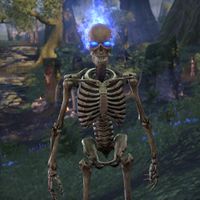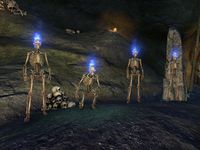Lore:Ehlnofey
The Ehlnofey (sometimes spelled Elhnofey)[1] of the Dawn Era are a group of beings who, along with the Hist, are counted among the original inhabitants of Nirn. They are depicted as vaguely Elven in shape, but featureless, similar to how they live on in fading memory,[2] and are widely considered to be the progenitors of the mortal races.[3][4][5][3] Perhaps because of their association with the land itself, "Old Ehlnofey" became another name for Aldmeris, the mystical homeland of the elves.[6][7] The language or languages of the Ehlnofey became known as Ehlnofex.[3] The term Ehlnofey in this language means Earthbones, but the word Earthbones is typically used to describe the Ehlnofey that followed the example of Y'ffre and sacrificed themselves to form the rules of nature.[5][UOL 1] Indeed, these followers of Y'ffre are known as the Earth Bones (or Earthbones), and it's been found that these "Earth Bones" can be manipulated to some extent.[3][8] Those that did not sacrifice themselves to become the laws of nature are typically referred to as the Ehlnofey.[UOL 1]
Origin[edit]
The exact nature of the Ehlnofey is a matter shrouded in much ambiguity. There are two major origins that are presented: one which describes the Ehlnofey as survivors of a previous world that settled Nirn after its creation, and another claiming them to be a group of et'Ada who were party to Nirn's construction and chose to remain in the world they'd crafted to stabilize it after the departure of Magnus and the Magna-Ge :
| Survivors of the Twelve Worlds | Et'Ada |
|---|---|
| According to the Anuad, when Anu formed Nirn following the shattering of the Twelve Worlds by Padomay, two surviving races originating from what Padomay had sundered were brought to the new world alongside the fragments of their realms which had been used to form it, the Ehlnofey and the Hist.
A group of Ehlnofey, those that would eventually become the progenitors of the Mer, arrived to the new world together alongside a relatively intact fragment of their former home, and attempted to live on as they had before, in their land which would come to be known as Old Ehlnofey. Another group, those who would become the progenitors to Men, were scattered across the new world, and had to wander and find each other over time. When the wandering Ehlnofey came across Old Ehlnofey, they were overjoyed to find their kin living among the splendor of ages past, but rather than welcoming them the inhabitants of Old Ehlnofey viewed them as degenerates, fallen and corrupted from their experiences in Nirn. In the end and for whatever reason, war broke out between those of Old Ehlnofey, mightier but fewer, and those that wandered, weaker but more numerous and hardened by survival. This destructive war would reshape the face of Nirn, sinking much of the land beneath new oceans, destroying much of the original realm of the Hist and creating the continents of Tamriel, Akavir, Atmora and Yokuda. The remains of Old Ehlnofey would become Tamriel while the wandering Ehlnofey would scatter to the newly formed continents. Eventually, over time and the passage of generations, the descendants of the two factions of Ehlnofey would gradually give rise to the various groups of Men and Mer. While this struggle occured, the "gods and demons" of the world, the Aedra, Daedra and Magna-Ge would form out of Anu and Padomay's spilled blood, as distinct groups from the Ehlnofey and from each other.[9] |
According to the Altmeri creation myth, when Magnus departed the Mundus, the et'Ada that took part in it's creation broke into groups, most would follow the flight of the God of Magic to become the Magna-Ge, but some of those present chose instead to stay after he departed and "sacrifice themselves into other forms so that they might stay" in the new world and work to keep it viable. These spirits would become known as the Ehlnofey.[4]
Among those Et'Ada who stayed, some would follow the example of Y'ffre, giving themselves to the Mundus fully to stabilize it and form the foundation of it's natural law, and would typically be referred to from that point on as "Earthbones" or "Earth Bones". Others would choose not to give themselves fully but to populate Nirn instead, having to "make children just to last" and this group would from that point typically be referred to as the "Ehlnofey".[UOL 1] The offspring of the Ehlnofey would exhibit a gradual change however, each consecutive generation was weaker than the one prior, more removed from their progenitors in stature and might. Through this generational phenomenon of diminishment the first Aldmer would arise, while the "weakest souls" that resulted from it would be formed by Lorkhan into armies he named "Men". Altmeri myth holds that Auri-El and Lorkhan and their respective followers would than war with one another, leading to the shattering of Altmora, the "Elder Wood" and one of the first kingdoms established by Auri-El alongside Old Ehlnofey, at Lorkhan's hands, and culminating in the removal of Lorkhan's Heart following his defeat.[3][4][5] At some point following the events of the war that occurred, the Aldmer are said to have left their doomed and ruined continent of Aldmeris and colonized southwest Tamriel in the Middle Merethic Era,[4][7] only to spend many centuries fruitlessly searching for their old homeland.[10] |
Legacy[edit]
We were the Y'ffre. Then we became the Ehlnofey, the Earth Bones. … "
—Guardian of the Earth
The fracturing of the Aldmer along cultural and racial lines is called the Sundering of Aldmeris, an event during which the Aldmer splintered into the groups that would become the Dwemer (Deep Ones), the Chimer (Changed Ones), the Bosmer (Green or Forest Ones), the Falmer (Snow Ones), the Maormer (Sea or Tropical Ones) of Pyandonea, the Altmer (Elder or High Ones), and the Sinistral Mer (Left-handed Ones) of Yokuda. The progeny of the Wanderers (Wandering Ehlnofey) became the races of men, eventually splitting into many different racial groups, including the Nedes, the Atmorans of Atmora, the Yokudans of Yokuda, and possibly the Tsaesci of Akavir, and other aboriginal groups (Proto-Bretons).[9]
Though the protean race is apparently gone, the Ehlnofey are not entirely forgotten. They are thought to have taken on students before they disappeared, passing their knowledge on to emerging races such as the Dwemer.[11] Knowledge of most individuals has been lost to time, but many prominent Ehlnofey appear in some form in the pantheons of the various races. The Ayleids of Cyrodiil are said to have preserved the Ehlnofey's Dawn Era magics and language to a greater extent than other Mer.[4] The theories of the Dwemer High Craftlord Kagrenac involved using sacred tones on the Heart of Lorkhan and bending the Earth Bones, commanding the "obedience" of the Ehlnofey.[8]
Nirn is said to be imbued with a wellspring of primordial energy which flows in a network via lines within the ground, described as the manner in which Druids visualize the Earthbones, places where these "bonelines" intersect are said to possess great power and have an effect on both magic and prayer performed there.[12][13] [14] According to some sources, the reason Nirn is filled with natural caverns is that in primordial times they formed a network that functioned like nodes or capillaries for the divine essence of the Aedra that created it. [15]
The earliest martial discipline of Nirn was the "Prismatic Vector Dance of the Ehlnofey", which was recorded and studied by the Demiprince Fa-Nuit-Hen.[16]
Lingering Ehlnofey[edit]
In the Second Era, what seemed to be lingering Ehlnofey spirits were still present in the Bone Orchard of southern Grahtwood.[17] Originally a group of "Old Bones" that wandered the lands, the travels of these gigantic beings unintentionally caused untold suffering in the lands they'd travel through, making them decide to seek a true death by being completely forgotten since, as long as they were remembered by the world, they could not truly die and leave it.[18] The last of this group, Dringoth, would continue to wander by himself, and so became feared by the Bosmer as a terrible destroyer who would absentmindedly trample their cities and hills under his feet while wandering through. The fearful Bosmer tricked and magically sealed Dringoth in slumber and, worried the restless remains of the other Old Bones might rise to wander again, brought them to the Bone Orchard, where the magic that ensnared Dringoth would imprison them as well.[19][18][20] As the site became a graveyard and shrine to Y'ffre tended by the Spinners , the Old Bones interred there could not be forgotten and so could not truly die. Some of the Orchard spirits would inhabit elven skeletons to move around, while others prefered to stay resting in their own massive and monstrous appearing bones. The Bone Orchard itself was constructed around the "hill" that was Dringoth's skull, and which the great Barrowbough tree that sealed him was planted on.This group would help foil an attempt by the Worm Cult to reanimate them into an army of giants by possessing the bones of the Bosmer buried in the Orchard and fighting alongside the Vestige, who used the power of a piece of Dringoth's rib to control or destroy the cult's undead, thus preventing the threat their reanimation would have posed to Tamriel. [21][18][17][22]
The Beldama Wyrd are a witch coven attuned to nature. They venerate the Breton interpretation of Y'ffre, Jephre.[23] They are guided by elemental spirits known as the Guardians,[24] which are among the extinct Ehlnofey who claim they were once Y'ffre.[25]
Some sources speak of sea-dwelling Ehlnofey with hearts made of pearl residing in old places of primordial energy, rivers and reefs where the Earthbones never quieted down.[12][13]
Cultural Significance[edit]
Altmer view themselves as "true children of the Et'Ada", descendants of the Aldmer and the Ehlnofey that preceded them. This belief was central to the ancestor worship of the Aldmer that eventually gave way to the Altmeri pantheon when the religion shifted from the worship of one's own ancestors to the worship of the ancestors of one's "betters", the most influential in their society. Most Altmer and Bosmer claim direct descent from Auri-El himself. Altmer also count deities like Trinimac, Syrabane and Phynaster among their ancestors[26][6][5][3][27]
Bosmer are known to worship Y'ffre. A vital part of the Bosmeri pantheon, Y'ffre's Ehlnofey, or "Earthbones," were created from his corporeal form to establish safety and the laws of nature. These laws took the shape of stories, and there is great debate between tribes competing to interpret Y'ffre's ways and knowledge of the times of chaos, before Y'ffre arrived on the mortal plane.[28] Some legends claim that the Boiche Elves, originating from the Earthbones that followed Jephre, grew the first great Graht-oak the out of the Perchance Acorn, which would become Tower of Green-Sap. Due to the nature of the Acorn being, perchance, elsewhere, many different Green-Saps sprung in many different forms, forming the walking Graht-Oak forests of the Valenwood. Each one told its own stories of the Green, the forest home of the "Boiche-become-Bosmer".[29] Some of the Bosmeri Spinners are connected to the Earthbones, although the exact nature of this connection is unknown.[30]
Ancient Aldmer were known to utilize magic associated with Ehlnofey in their arcane craftsmanship.[31] According to the legend of the Viridian Sentinel, long ago the Direnni forged a covenant with the Earth Bones to protect their settlements from the wild. The Bretons, who displaced the Direnni, had no such arrangement, and as a result, their farms in Bangkorai were gradually overrun by the wilderness. The people were pushed to the brink of starvation, causing a young boy Greenward to pray to Stendarr for salvation. Stendarr taught him to forge a new pact with the forest, giving him the power to restrain the natural creatures within. He thus became the first Viridian Sentinel.[32]
Reachfolk honor a diverse array of nature spirits, incarnations of nature birthed from the Green, the lifeforce of Nirn's natural world, created in the Dawn Era by the sacrifice of Y'ffre and the Earthbones.[33][34][35][36][37] The spirits honored by the Reachfolk can have distinct characteristics, such as the spirits associated with springs, trees or sacred animals.[38][39] Their shamans occasionally utilize calming spirits that may inhabit their staves.[40] Expressing gratitude to nature spirits, they make it a practice to thank them before felling trees and replace them by planting new ones.[39]
Y'ffre and the Earthbones play a central role in the beliefs of both Druids and Wyrd.[41].The Druids commune with the voices of Y'ffre and the Earthbones for guidance and tap into their power through their magic.[36][42]. The Wyresses believe that during Y'ffre's Naming, the act which gave all life on Nirn it's shape,[43] the deity tasked the Earthbones to choose those who would become the guardians of nature,[44] a task ultimately given to the Wyresses, the Name-Daughters, who are descendants of the Ehlnofey themselves.[23]
Gallery[edit]
Notes[edit]
- The war between the Ehlnofey described in The Annotated Anuad bears many striking parallels with the war between Lorkhan and Auriel described in The Monomyth, and the texts are likely summarizing the same events from different historiographical perspectives.
- Trinimac has been described as the "greatest knight of the Ehlnofey, champion of the Dragon of Time" in certain Cyrodiilic folktales.[45]
- Ehlnofex has been described as a dangerous language with characters that constantly distort as one looks at them.[UOL 2]Inscriptions in Ehlnofex have been used to transport people and objects through time.[46]
- Some theories propose that the use of the term "Dwarves" to refer to the Dwemer originates from ancient times when they were the "brilliant students" of the Ehlnofey with the sobriquet having been given to them by their titanic mentors.[11]
- Bones originally belonging to or possessed by the Ehlnofey are said to glow with great Magicka, despite appearances such remains have no traces of necromancy and even exhibit a degree of resistance to necromantic interference. [20]
See Also[edit]
- For game-specific information, see the Elder Scrolls Online article.
Books[edit]
- The Annotated Anuad — Early religious book providing a simplified version of The Anuad creation myth from the Mythic Era
- Before the Ages of Man by Aicantar of Shimerene — Chronicles the major events of the Dawn and Merethic Eras
- The Monomyth — A theological book containing the common creation myths
References[edit]
- ^ Pocket Guide to the Empire, 1st Edition: Skyrim — Imperial Geographical Society, 2E 864
- ^ Elusive Ehlnofey Statuette
- ^ a b c d e f The Monomyth
- ^ a b c d e Before the Ages of Man — Aicantar of Shimerene
- ^ a b c d Varieties of Faith... — Brother Mikhael Karkuxor of the Imperial College
- ^ a b Pocket Guide to the Empire, 3rd Edition: The Blessed Isle: Alinor and the Summersets — Imperial Geographical Society, 3E 432
- ^ a b Pocket Guide to the Empire, 3rd Edition: All the Eras of Man, A Comprehensive History of our History — Imperial Geographical Society, 3E 432
- ^ a b Baladas Demnevanni's dialogue in Morrowind.
- ^ a b The Annotated Anuad
- ^ Father Of The Niben — Florin Jaliil
- ^ a b Pocket Guide to the Empire, 1st Edition: Hammerfell — Imperial Geographical Society, 2E 864
- ^ a b Stormweaver's Cavort codex entries in ESO: Firesong
- ^ a b Pearls of Ehlnofey codex entries in ESO: Markarth
- ^ Visitor's Guide to Y'ffre's Cauldron — Bernardine Gelves, Associate Chancellor of Cultural Heritage
- ^ Weeping Wind Cave loading screen in ESO
- ^ Lord Fa-Nuit-Hen and Tutor Riparius Answer Your Questions 2 — Fa-Nuit-Hen and Tutor Riparius
- ^ a b Dringoth's dialogue in ESO
- ^ a b c Olphras's dialogue in ESO
- ^ Last of the Old Bones
- ^ a b Bone Orchard Research — Bonelord Ethruin
- ^ Events of Keeper of Bones in ESO
- ^ Dringoth's Rib effect in ESO
- ^ a b Witch Cults of Northern High Rock — Wafimeles Masteret (Lorekeeper)
- ^ Wyress Ileana's dialogue in ESO
- ^ Guardian of the Earth's dialogue in ESO
- ^ The Onus of the Oghma — Phrastus of Elinhir
- ^ A Rejection of Open Borders — Kinlady Avinisse of Shimmerene
- ^ The Improved Emperor's Guide to Tamriel: Valenwood — Flaccus Terentius, 2E 581
- ^ Aurbic Enigma 4: The Elden Tree — Beredalmo the Signifier
- ^ Earthbone Spinner in Legends
- ^ Pearls of Ehlnofey's antiquity codex entries in ESO
- ^ The Viridian Sentinel
- ^ Frii's dialogue in ESO
- ^ The Ooze: A Fable
- ^ Psijic Style description in ESO
- ^ a b Druid Audrine's dialogue in ESO
- ^ Druid Laurel's dialogue in ESO
- ^ Great Spirits of the Reach: Volume 2 — Vashu gra-Morga, Chief Daedrotheologist at the University of Gwylim
- ^ a b Malug's dialogue in ESO: Markarth
- ^ Staff of the Spirit Within
- ^ Wyrd and Druid
- ^ Legacy of the Bretons — Stefan Mornard
- ^ Wild Hunt Crown Crate season description in ESO
- ^ Wyresses: The Name-Daughters — Glargargil the Speaking Oak
- ^ Lord of Souls — Greg Keyes
- ^ Events of The Ebon Sanctum questline in ESO: Summerset
Note: The following references are considered to be unofficial sources. They are included to round off this article and may not be authoritative or conclusive.
|
|||||||||||||||||||||||||||||||||||||||||
|
|||||||||||||||||
|
|||||||||||
|
||||||||||||||||||||||||||
|
||||||||||||||||||||||||||||||||||

